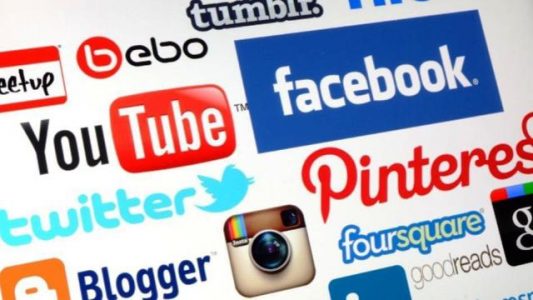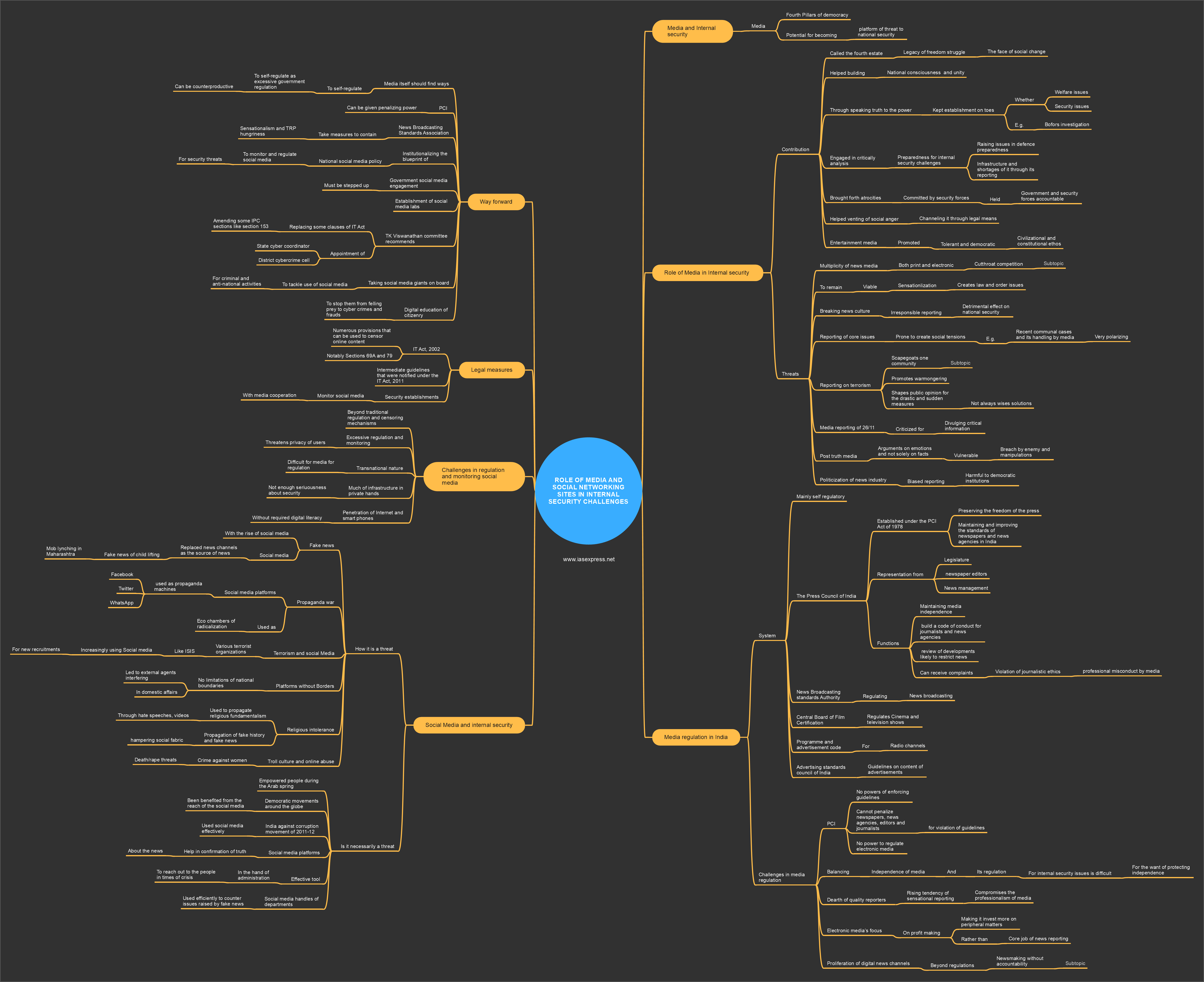[Mains Static] Role of Media and Social Networking Sites in Creating Internal Security Challenges

The Media and social networking sites are fast becoming a double-edged sword in the internal security regime. The digital and data revolution has exponentially increased the reach of traditional/digital media and social media. The potential of threats emanating from media to internal security is immense. In this article we shall discuss both sides of the two faces of new age media.
This topic of “[Mains Static] Role of Media and Social Networking Sites in Creating Internal Security Challenges” is important from the perspective of the UPSC IAS Examination, which falls under General Studies Portion.
Media and Internal security
Though media is known as the fourth pillar of democracy, its recent performance, both print and electronic, had cast a doubt over the notion. In fact, it has opened a new dimension of threats to India’s Indian security scenario.
What is the role of media in national security?
- Media is called the fourth estate. It has a legacy of freedom struggle and has always been the face of social change.
- It has helped to build national consciousness and unity through its professional reporting in difficult times.
- By speaking truth to the power, it has kept establishment at the toes whether it is a welfare issue or a security issue. The Bofors investigation was able to unearth serious corruption in the defence procurement.
- It has engaged in critical analysis of preparedness for internal security challenges through raising issues in defence preparedness, Infrastructure, and shortages of it through its reporting. The policy debates on media has been helpful in policy formulations from initial days.
- It has brought forth atrocities committed by security forces when and where they happened. By this it held the government and security forces accountable.
- It has helped to vent of social anger and channeling it through legal means. The media always helps in the right exposure of social anger and makes the establishment less susceptible to revolt.
- The entertainment media such as cinema, television, and other art forms have always promoted basic tolerant and democratic civilizational and constitutional ethos through its means. It has helped in strengthening the composite society of India.
What are the challenges to internal security due to Media?
Though the media has been effective in its work, recently it is becoming less responsible and jeopardizing the security environment.
- The multiplicity of news media, both print, and electronic media has made the competition very cutthroat. To remain viable, newspapers (mainly local or regional) and electronic, resort to sensationalizing of the news. This many times creates law and order problems.
- The Breaking news culture has sometimes resulted in irresponsible reporting which has a detrimental effect on national security.
- The media’s reporting of core issues that are prone to create social tensions. The recent communal cases and its handling by media were very much polarizing according to many social activists. This sows social animosity which acts as a time bomb of social tension waiting to explode.
- Media’s reporting on terrorism has been questioned from time to time. It scapegoats one community, promotes warmongering, and shapes public opinion for the drastic and sudden measures to tackle terrorism which are not always wise.
- The media reporting of 26/11 was criticized for divulging critical information in the petty TRP race.
- The post-truth media bases its arguments on emotions and not solely on facts making it vulnerable to breach by enemy and manipulations.
- Politicization of news industry and biased reporting is harmful to democratic institutions. The loss of independence of the fourth estate has been a serious concern.
How media is regulated in India?
Media in India is mainly self-regulatory. The existing bodies such as the Press Council of India and News broadcasting standards Authority are self-regulatory in nature.
- The Press Council of India
- The PCI was established under the PCI Act of 1978 for the purpose of preserving the freedom of the press and of maintaining and improving the standards of newspapers and news agencies in India.
- The membership has representation from legislature, newspaper editors, news management.
- It helps in maintaining media independence, build a code of conduct for journalists and news agencies, review of developments likely to restrict news.
- It can receive complaints for violation of journalistic ethics, professional misconduct by media, demand explanations. Decisions of PCI are binding and cannot be appealed before a court of law.
- Central Board of Film Certification regulates Cinema and television shows etc.
- Radio channels have to follow programme and advertisement code.
- Advertising standards council of India has drawn up guidelines on the content of advertisements.
What are the challenges of media regulation for security problems?
- The PCI has no powers of enforcing guidelines. It cannot penalize newspapers, news agencies, editors and journalists for violation of guidelines. It does not have the powers to review the functioning of electronic media
- The balancing between independence of media and its regulation for internal security issues is difficult as any attempt to regulate invariably results in a cry of a threat to media independence.
- The dearth of quality reporters and the rising tendency of sensational reporting compromises the professionalism of media.
- The electronic media’s focus on profit-making is making it invest more on peripheral matters rather than the core job of news reporting.
- Proliferation of digital news channels on platforms like YouTube is beyond regulations and they propagate news without any responsibility. This endangers the entire news channel ecosystem.
Social media and internal security
In the internet of things, ideas take a gigantic leap every day and disruption (both good and bad) is the norm. One such disruption which has revolutionised the way information is exchanged in real-time has been the advent of Social media. It has challenged information hierarchies, opened up access, and produced an entirely new ecosystem of information exchange. The disrupting nature of social media also brings with it many security challenges.
The mass exodus of north-eastern Indians from urban areas from all-over India made policymakers to seriously note social media’s ill effects.
How social media/social networking sites is a threat to internal security?
- Fake news
The phenomenon of fake news has grown leaps and bounds with the rise of social media. The social media has largely replaced news channels as the source of news. Facebook, Twitter and other social media platforms are the first source of news reporting to the digital generation.
e.g. The fake news and its effects were realized in Maharashtra mob lunching over fake news of child lifting
- Propaganda war
The social media platforms like Facebook pages and WhatsApp groups are being used as propaganda machines. They act as echo chambers of radicalism and result in radicalized citizenry.
- Terrorism and social media
Various terrorist organizations like ISIS are increasingly using Social media for new recruitments. The unregulated social media websites become relatively safer points of contacts for these terrorist organizations.
- Platform without boundaries
The social media platform has no limitations of national boundaries. This has led to external agents interfering in domestic affairs.
- Social media and religious intolerance
Social media is increasingly being used to propagate religious fundamentalism. The propagation of fake history and fake news spreading is hampering the social fabric of the country. Propagation of hate speech is easily being done through social media.
- The troll culture and online abuse, death/rape threats on social media is rising. The women members of social media are largely the targets of these attacks.
- The rapid spread of false information through social media is among the emerging risks identified by the World Economic Forum in its various reports.
Is social media necessarily only a threat?
Social media is just a tool of communication. Hence any quality judgment must consider the user of the tool and their standing in the society. If anti-social and anti-national elements use it to threaten our country, we can always use it to our benefit.
- The social media has empowered people during the Arab spring.
- The democratic movements around the globe have been benefited from the reach of social media.
- The India against corruption movement of 2011-12 used social media very effectively.
- Many social media platforms help in confirmation of truth about the news and containing the spread of fake news.
- Social media is an effective tool in the hand of the administration to reach out to the people in times of crisis.
- Social media handles of various administrative departments have been used efficiently to counter issues raised by fake news.
What are the challenges in regulating and monitoring social media?
- The social media is beyond traditional regulation and censoring mechanisms.
- The transnational nature of social media makes it difficult for national governments. The data storage of social media is not local bringing jurisdictional issues in tackling crimes through social media.
- Much of the infrastructure is in the hands of private companies who see measures of security and regular auditing as unnecessary costs making it difficult to protect people from social media related crimes.
- The penetration of the internet and smartphones to rural India makes it impossible to contain the effects of social media issues.
What are legal measures to contain social media?
- The social media platforms come under the purview of the Information Technology Act, 2000, the intermediate guidelines that were notified under the IT Act, 2011.
- The IT Act contains numerous provisions that can be used to censor online content – notably in Sections 69A and 79.
- The security establishments monitor social media platforms to find any threat and try to minimize it.
- Many hateful platforms have been taken down from social media platforms by cooperation with those platforms.
What more can be done to contain the security issues through media and social platforms?
- The media itself should find ways to self-regulate as excessive government regulation can be counterproductive.
- The PCI can be given penalizing power so that it can better manage the media for professionalism and information accuracy.
- News Broadcasting Standards Association should take measures to contain sensationalism and TRP hungriness in News channels.
- Institutionalizing the blueprint of national social media policy to monitor and regulate social media for security threats.
- Government social media engagement must be stepped up.
- Establishment of social media labs.
- TK Viswanathan committee recommends replacing some clauses of IT Act and amending some IPC sections like section 153. It also recommends the appointment of state cyber coordinator, district cyber crime cell.
- Taking social media giants on board to tackle the use of social media for criminal and anti-national activities.
- Digital education of people should be done to make people aware of the ill effects of social media. It can help to prepare people in securing from falling prey to the agenda of vested interests.
- Cybersecurity must be expanded with cyber intelligence. Utilizing artificial intelligence and Big data analysis for tracking criminal activities in cyberspace.
- Social media platforms benefit from the traffic. They must be brought under the regulatory regimes and made accountable to security regimes and national governments.
- Smart policing must be the new face of policing in India. Digital training of police must be done to better equip them against online threats and instances of cyberterrorism.
Traditional and social media is becoming the new platform of security threat. The national governments must update their security apparatus to fight the menace. Cyberspace has become the fifth theatre of warfare. The Media is a bulwark of democratic India. Its purity is as much important as its independence.
Practice Question for Mains
The social media platforms are coming under the target of fundamentalist activities. discuss its effects on internal security. (250 words)

